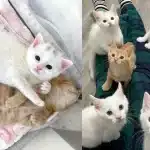Here you’ll find several cat wet food feeding charts to help you figure out how much wet food you should be feeding your cat every day. We’ve broken down the feeding charts by weight (oz), 6oz can portions, and calories to give you as much information as possible. It’s important to refer to a cat wet food feeding chart in order to give your cat just the right amount for optimal health.
Cat Wet Food Feeding Chart By Ounce
The chart below shows general recommendations in ounces of how much wet food you should feed your cat each day.
| | 5lb | 10lb | 15lb | 20lb |
| Kitten | 7.7oz | 13oz | 17.8oz | 21.8oz |
| Lean Cat | 4.1oz | 6.7oz | 8.6oz | 10.6oz |
| Overweight Cat | 4.3oz | 5.8oz | 6.7oz | 7.4oz |
| Pregnant Cat | 5.8oz | 9.4oz | 12.2oz | 14.6oz |
Cat Wet Food Feeding Chart By Can Portion
The chart below shows how much wet food you should be feeding your cat daily by portions of a 6oz can.
| | 5lb | 10lb | 15lb | 20lb |
| Kitten | 1.3 cans | 2.2 cans | 3 cans | 3.6 cans |
| Lean Cat | 0.7 cans | 1.1 cans | 1.4 cans | 1.8 cans |
| Overweight Cat | 0.7 cans | 1 can | 1.1 cans | 1.2 cans |
| Pregnant Cat | 1 can | 1.6 cans | 2 cans | 2.4 cans |
Cat Wet Food Feeding Chart By Calories
The chart below shows how much wet food you should be feeding your cat daily by calories. You can find the calories in a can of wet food by looking up the can on the brand’s website.
| | 5lb | 10lb | 15lb | 20lb |
| Kitten | 320 cal | 540 cal | 740 cal | 910 cal |
| Lean Cat | 170 cal | 280 cal | 360 cal | 440 cal |
| Overweight Cat | 180 cal | 240 cal | 280 cal | 310 cal |
| Pregnant Cat | 240 cal | 390 cal | 510 cal | 610 cal |
Other Factors Affecting How Much Wet Food to Feed Your Cat
These charts should be used only as a starting point in determining how much to feed your cat. There are other factors that will affect how much wet food to feed your cat daily. As such, you should adjust amounts over time if you notice your cat gaining or losing weight. Some of these factors are:
- Weight and Lean Mass – Bigger, leaner cats will require more energy than smaller cats. Also, the proportion of fat to lean mass will make a difference. A heavy cat that is mostly lean mass will need more calories than a heavy cat that is mostly fat mass.
- Age – Kittens require a lot more energy than adult cats. Senior cats need less food overall.
- Pregnancy – Pregnant and nursing cats need a lot more food as they’re feeding and growing kittens. Consult your vet for more recommendations here.
- Metabolism – Some cats have a higher metabolism (use more energy) simply due to their genetics. Cats will also have a higher metabolism if they’re exercising more. You’ll need to provide more food for a cat with a higher metabolism.
- Cat Food Brands and Flavors – Cat wet food calorie content will change based on the brand and flavor. For instance, a 3oz can of Fancy Feast Whitefish and Tuna Pate contains 85 calories, while a 3oz can of Friskies Chicken and Tuna Pate contains 97 calories. That’s almost a 10% difference in calories!
- Whether You’re also Feeding Dry Food – You’ll need to recalculate the amount of food to feed your cat if you’re doing a mixture of dry and wet food. Remember, it’s the overall calories that matter.
Why Measuring Wet Food Daily is Important
Feeding your cat just the right amount of food every day is important to maintain good health. Giving your cat too little can cause malnourishment and make your cat underweight. Feeding too much can lead to obesity, which has its own host of problems such as diabetes and heart issues. The charts above give recommendations on wet food portion sizes for overweight cats to help them lose weight.
In the end, feeding your cat the right amount of food will help them live a long and happy life.














